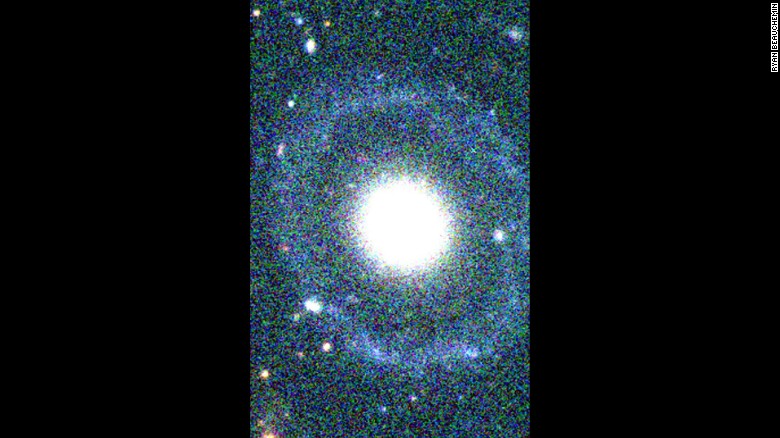Ultra-rare galaxy could be 'one of a kind'CNN
By Ashley Strickland,Updated 12:08 PM ET, Wed January 4, 2017
 PGC 1000714 was initially thought to be a common elliptical galaxy, but a closer analysis revealed the incredibly rare discovery of a Hoag-type galaxy. It has a round core encircled by two detached rings.
PGC 1000714 was initially thought to be a common elliptical galaxy, but a closer analysis revealed the incredibly rare discovery of a Hoag-type galaxy. It has a round core encircled by two detached rings. (CNN) — For a long time, no one noticed the uniqueness of the little galaxy named PGC 10000714, which existed 359 million light-years from Earth.
A few years ago, it caught the attention of researcher Patrick Treuthardt as he analyzed a span of galaxies. At first, he thought it was a small, fairly common elliptical galaxy that happened to be more circular than usual. But a closer look revealed that he had stumbled across something incredibly rare.
At the heart of the galaxy was a 5.5 billion-year-old round, red core. It was encircled by a 130 million-year-old faint blue ring, with nothing connecting it. Treuthardt's finding matched the description of a Hoag-type galaxy.
Further analysis revealed something even more surprising: an older, diffuse red inner ring around the core.
"It was like spotting a snow leopard or some other rare and elusive animal," Treuthardt said. "A Hoag-type galaxy, one with a single circular ring surrounding a round core, is already very rare, but finding one with potentially two very regular rings is quite unique.
"One estimate states that Hoag-type galaxies may make up 0.1% of observable galaxies, and it could be much less than that. You would be more likely to be dealt four of a kind in a hand of five-card poker. This galaxy may be one of a kind."
Most galaxies have a bar or visible disk structure that shows how the core and its rings are connected. Usually, the rings aren't symmetrical because they form due to galaxies interacting with other galaxies or their environment. This galaxy's round core and ring defy both of those properties and challenge theories.
He discovered that although PGC 10000714 was included in catalogs of galaxies, there was no description to match it.
Treuthardt, an astrophysicist at the North Carolina Museum of Natural Sciences, worked with a team of researchers to image and study the galaxy. They used multi-waveband images from a large-diameter telescope to determine the age of its features. Their research was published in a study on Wednesday.
To Burcin Mutlu-Pakdil, a Ph.D. candidate at the Minnesota Institute for Astrophysics, it resembled Hoag's Object. Named for the astronomer who discovered it in 1950, Hoag's Object is a non-typical ring galaxy with a round core and perfect, detached outer ring with no signs of a hidden substructure.
Hoag-type galaxies strongly resemble this and are extremely rare. Their origin is debated, Mutlu-Pakdil said. Usually, their structure differs and is more disc-like rather than round.
So few of them are known that scientists still don't have definite conclusions about their nature, evolution or systematic properties.
When Mutlu-Pakdil analyzed the galaxy, she was so surprised by the second inner ring that she checked the analysis multiple times. Each time, she received the same result.
"Then I realized one more time that the universe is full of surprises and we still have a lot to learn," she said.
One possibility for why these galaxies are so rare could be traced to the rings themselves. Compared with the rest of the galaxy they are attached to, the rings may not have a long life or may form only under certain conditions, Treuthardt said.
Because the two rings are different colors and ages, the galaxy could have experienced two periods of formation and growth. Another possibility is that the outer ring was acquired as the galaxy included parts of a neighboring galaxy, according to the study.
But the data for PGC 10000714 are limited. In order to learn how the rings formed, Treuthardt said, researchers will need infrared images and spectroscopic data. He also wants to investigate the inner portions and structure of the galaxy and discover more about its gas environment.
"By really understanding how this galaxy and others like it may have formed and evolved, it helps us better understand galaxy formation and evolution in general," Treuthardt said. "Outliers like PGC 1000714 challenge our theories, which is an important aspect of science."
http://www.cnn.com/2017/01/04/us/rare-hoag-galaxy-discovered/index.html